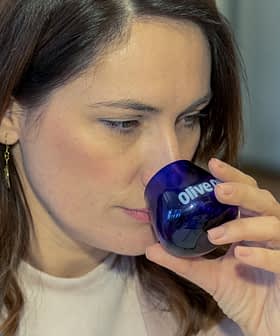The International Olive Council (IOC) validated a red tasting glass as an alternative to the common cobalt blue cup currently used by those who perform sensorial analyses of olive oils.
The new tool had been presented by representatives of the University of Jaén and the Spanish company Elaia Zait to the committee of experts of the International Olive Council, who then stated that it meets the standards adopted by the Organization for sensory analyses of olive oils.
“This is the result of an innovation project that we have carried out at the University of Jaén for the company Elaia Zait,” José J. Gaforio, who developed the new glass with Miguel Ángel Rubio and Alfonso Martínez, told Olive Oil Times. “The IOC’s validation of the red garnet tasting glass is an important milestone for the olive oil sector as it represents an innovation that improves the organoleptic analysis of virgin olive oils. Its main characteristic is that it totally neutralizes the color of the oils, avoiding biases in the analysis.”
This shade of red was selected for its ability to make olive oil appear colorless from the outside, said the IOC, which highlights the compliance with standard COI/T.20/Doc. No. 5 of the Method for the Organoleptic Assessment of Olive Oil: “Made of dark-colored glass to prevent the taster from perceiving the color of the oil, thus eliminating any prejudices and impeding the possible formation of biases or tendencies that might affect the objectiveness of the determination.”

The color red, however, has also been found to hinder motivation and the ability to think, and trigger strong, often negative psychological responses, noted Olive Oil Times publisher Curtis Cord in a tweeted response to the creators of the new glass in 2017.
“What’s worse: a pleasing blue vessel that not entirely conceals the color of an oil sample, or a glass that’s red — nature’s cue for danger, the symbolic color of warning signs and poison labels?” Cord asked.
“Red is perhaps the most manipulative color, influencing everything from your behavior in the workplace to your love life,” the BBC’s David Robinson wrote in an article that underscored the power of red to influence how we perceive things.
Andrew Elliot at the University of Rochester in New York found that “people performed worse on cognitive tests if they were given to the participant in a red cover slip,” the BBC reported.
And, as Juliet Zhu, a University of British Columbia psychologist noted, “Think about red, and what comes to mind: stoplights, stop signs, danger, ambulances. Blue is the color of the sky, the ocean, safety. When their environment is safe, people are more explorative.”



